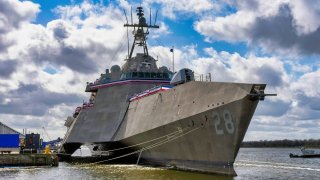The U.S. Navy's Nightmare Littoral Combat Ship Program Looks Finally Over
The U.S. Navy has christened the USS Pierre (LCS-38), the last of the Independence-class Littoral Combat Ships.
Summary: The U.S. Navy has christened the USS Pierre (LCS-38), the last of the Independence-class Littoral Combat Ships.
Littoral Combat Ship Key Points and Facts from Author Peter Suciu, Defense Expert
-Despite numerous issues and early retirements of the class, the Navy has repurposed these vessels for modern mine countermeasure missions, enhancing mine countermeasure forces in Bahrain.
-USS Pierre will begin sea trials this summer and is expected to be commissioned in early 2024.
USS Pierre: The Final Independence-Class Littoral Combat Ship Joins the Fleet
To paraphrase the late President Gerald R. Ford, the U.S. Navy's long nightmare is over – almost. The Littoral Combat Ship (LCS) program hit a notable milestone this month, as the sea service christened the USS Pierre (LCS-38) at a ceremony at Austal's shipyard in Mobile, Alabama last Saturday. LCS-38 is only the second U.S. Navy vessel named after South Dakota's state capital following the PC-461-class submarine chaser built during the Second World War.
The USS Pierre is the 19th and, more importantly, the last of the Independence-class variant LCS vessels. She will begin sea trials this summer, before being handed over to the United States Navy. The small warship is now on track to be formally commissioned in San Diego early next year.
It will likely be the final Littoral Combat Ship to enter service.
Littoral Combat Ship: A Class of Problems
Along with the Freedom-class variant, the Independence-class was part of the LCS program conceived in the mid-2000s to develop multirole warships that could operate close to shores where larger warships could not.
Notably, the U.S. Navy opted for two unique classes – each slightly smaller than the Oliver Hazard Perry-class frigates (FFGs) they were meant to replace.
On paper, the stealthy surface combatants were seen as ideal for countering missile-firing boats, small submarines, and other threats in littoral or near-shore waters. Both classes of LCS vessels were meant to emphasize speed, while the concept called for the warships to utilize flexible mission modules. However, Congress cut the funding for the mission modules, while breakdowns were common. In essence, the U.S. Navy was left with small and fast ships that have even earned the moniker "Little Crappy Ships" by some sailors.
As a result, the U.S. Navy has sought to retire some of the oldest of the LCS warships years before their expected end of service life, even as newer vessels continued to be produced!
New Mission Possible for LCS
After literal billions of dollars had essentially been thrown into a proverbial hole in the water, the U.S. Navy has finally found a role for the LCS as a modern mine countermeasure vessel.
The sea service's Mine Countermeasures Mission Package (MCM MP) – the first of which has been instead on the USS Canberra (LCS-30) – includes a suite of sensors, unmanned vehicles, and support systems that allow for remote mine detection, identification, and neutralization
Harrison Kass writing for The National Interest, this week reported that the U.S. Navy will now homeport four Independence-class LCS vessels in Bahrain to enhance mine countermeasure forces in the region. It will allow for the aging Avenger-class – introduced for mine countermeasures in the 1980s – to be retired.
"The littoral combat ship was always supposed to have the ability to conduct minehunting capabilities, but the Remote Minehunting System, which was originally designed to be installed in the vessels, failed reliability tests. The Navy started from scratch to develop the mine countermeasure module that is now being integrated into the Independence-class," Kass wrote.
It would seem that the U.S. Navy has finally found a role for the Littoral Combat Ship – but it would seem like it took too long to get to this point. Whether the USS Pierre will serve in such a capacity also has yet to be seen.
Author Experience and Expertise: Peter Suciu
Peter Suciu is a Michigan-based writer. He has contributed to more than four dozen magazines, newspapers, and websites with over 3,200 published pieces over a twenty-year career in journalism. He regularly writes about military hardware, firearms history, cybersecurity, politics, and international affairs. Peter is also a Contributing Writer for Forbes and Clearance Jobs. You can follow him on Twitter: @PeterSuciu. You can email the author: [email protected].


